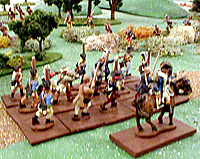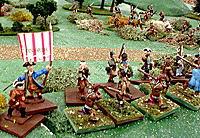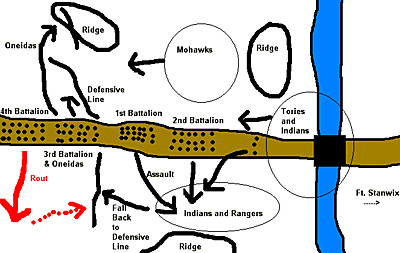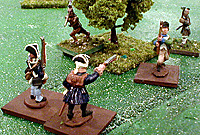
Tories and Indians ambushed four battalions of Patriots marching from Albany to Ft. Stanwix during the American Revolution. This bloody battle was the subject of Dale Edwards' "Oriskany" scenario at Cold Wars 2003. The battlefield featured a road running down the length of the board, with a bridge across a river near one end. On either side of the road was scattered brush and trees, with a few hills. The four Patriot battalions were on the road in march column, with three scouts out in front, and a small band of Oneida Indians near the rear. Their opponents included a large band of Mohawk Indians on the left of the column; another group of Indians with Rangers mixed in on the right, and yet more Tories and Indians ahead.
Fortunately, at the historical battle the Indians gave away the ambush too soon so the column was only half way into the trap. I say fortunately because I found myself commanding the first two battalions, and one more move down the road and I would have never gotten out of there alive. The Patriots needed to exit the opposite end of the board to win; the Tories needed to drive the Patriots back the way they came. Failing that the Tories needed to inflict twenty more casualties than they suffered themselves. The battle would end prematurely if the Tories and Indians reached 50% casualties.
 This entertaining 25 mm skirmish
battle was fought using Dale's own "Five by Eight Card"
rules, a fitting title since they did indeed fit on a five by
eight index card. The rules were very easy; easy that is for
everyone except me. For some reason I managed to misunderstand
several important points, a failing that must have annoyed Dale
and my opponents, although they were too polite to complain.
All figures moved 6", minus an inch for rough terrain. Combat
was resolved by rolling a ten-sided die. All figures could fire
12", Indians hitting on a roll of 9-10; Tories and Patriots
hitting on 8-10 (minus one for shooting at targets in cover).
In melee each combatant eliminates his opponent on a roll of
8-10, with a bonus if you had a 3-1 advantage in numbers.
This entertaining 25 mm skirmish
battle was fought using Dale's own "Five by Eight Card"
rules, a fitting title since they did indeed fit on a five by
eight index card. The rules were very easy; easy that is for
everyone except me. For some reason I managed to misunderstand
several important points, a failing that must have annoyed Dale
and my opponents, although they were too polite to complain.
All figures moved 6", minus an inch for rough terrain. Combat
was resolved by rolling a ten-sided die. All figures could fire
12", Indians hitting on a roll of 9-10; Tories and Patriots
hitting on 8-10 (minus one for shooting at targets in cover).
In melee each combatant eliminates his opponent on a roll of
8-10, with a bonus if you had a 3-1 advantage in numbers.
The sequence of play was simple: Tories & Indians move, Patriots shoot, melee, Patriots move, Tories & Indians shoot, melee again. On turn one the Mohawks were not allowed to move. There were no morale checks during the battle, but one of the patriot battalions would rout automatically on turn one and head for the edge of the board. Their commander could roll a die for each figure at the start of each subsequent turn and rally him on a roll of 10. We also had an accurate weather report before the battle. Dale warned us that there would be a brief downpour, starting on turn five, which would prevent firing and force us to disengage from any ongoing melees
 After a historical briefing (complete
with snap shots of the battlefield) we chose sides and the battle
began. It was obvious to me that if my battalions hesitated in
the road I would be cut to pieces. I resolved to send all my
men into the brush to the right to engage the Indians and Rangers
in melee as quickly as possible.
After a historical briefing (complete
with snap shots of the battlefield) we chose sides and the battle
began. It was obvious to me that if my battalions hesitated in
the road I would be cut to pieces. I resolved to send all my
men into the brush to the right to engage the Indians and Rangers
in melee as quickly as possible.
I hoped that by "hugging" the enemy and moving into the brush I would take fewer casualties from the muskets of the other Indians and Tories. I also hoped to exploit the fact that my men were concentrated, but the enemy was spread out. So off my men went, taking fearful casualties as they charged the enemy. The Rangers really had the range (aided by a bonus for their first volley), and I could only get a few of my men into melee on turn one.
To make matters worse my dice were cold and I took the worst of the hand-to-hand fighting. For a couple of turns I was afraid I wouldn't make it, but eventually I carried the position by weight of numbers before significant reinforcements could arrive. I immediately began an orderly withdrawal to set up a good defensive line.
At the back of the column battalion four routed and moved steadily towards the board edge. My teammate moved battalion three off the road to the left and into a good defensive line in the brush. He was attacked by the Mohawks, but held his own in the firefight and managed to gain the enemy's flank with the Oneidas before the rain began. The downpour allowed both sides to establish their positions.
The Patriots were in a bent line, with my surviving soldiers perpendicular to the road on the right and the third battalion at a bit of an angle off to the left. We were also able to use the time to move some stragglers from the routing fourth battalion back into the front lines.
 The Tories and Indians were in a rough semicircle facing us just
outside musket range, with the bulk of their force threatening
the road itself, where the two Patriot commands met, and a small
group of Indians threatening my right flank.
The Tories and Indians were in a rough semicircle facing us just
outside musket range, with the bulk of their force threatening
the road itself, where the two Patriot commands met, and a small
group of Indians threatening my right flank.
When the rains stopped we had turned the tide of battle in our favor. We had enough firepower lined up to give the enemy a bloody nose if they tried to close with us. They outnumbered us, so they might still prevail by rushing us with all their men, casualties be damned, and getting to melee. Even this strategy was unlikely to succeed since they were rapidly approaching 50% casualties, which would end the battle.
After probing the flank and the center they advanced a line of Tories in my direction while the Indians stayed out of range. One round of hot dice and the Tories were wiped out, ending the battle. After totaling the casualties of both sides it was found they Patriots had suffered more casualties, but the difference was small. The battle was a win for the Patriots.
Back to Table of Contents -- Junior General Report #2
Back to Junior General Report List of Issues
Back to MagWeb.com Magazine List
© Copyright 2003 by Matt Fritz.
This article appears in MagWeb.com (Magazine Web) on the Internet World Wide Web. Other articles covering military history and related topics are available at http://www.magweb.com